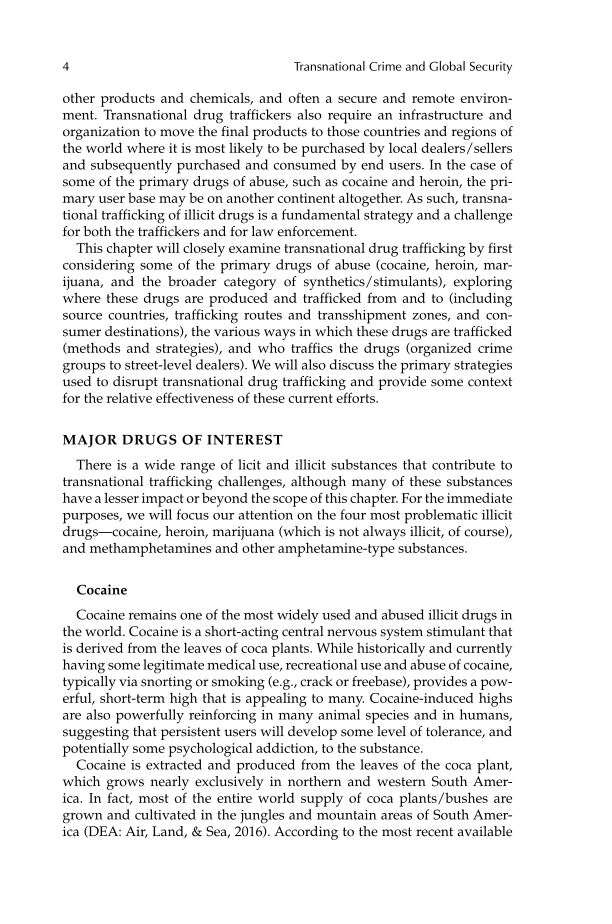4 Transnational Crime and Global Security
other products and chemicals, and often a secure and remote environ-
ment. Transnational drug traffickers also require an infrastructure and
organization to move the final products to those countries and regions of
the world where it is most likely to be purchased by local dealers/sellers
and subsequently purchased and consumed by end users. In the case of
some of the primary drugs of abuse, such as cocaine and heroin, the pri-
mary user base may be on another continent altogether. As such, transna-
tional trafficking of illicit drugs is a fundamental strategy and a challenge
for both the traffickers and for law enforcement.
This chapter will closely examine transnational drug trafficking by first
considering some of the primary drugs of abuse (cocaine, heroin, mar-
ijuana, and the broader category of synthetics/stimulants), exploring
where these drugs are produced and trafficked from and to (including
source countries, trafficking routes and transshipment zones, and con-
sumer destinations), the various ways in which these drugs are trafficked
(methods and strategies), and who traffics the drugs (organized crime
groups to street-level dealers). We will also discuss the primary strategies
used to disrupt transnational drug trafficking and provide some context
for the relative effectiveness of these current efforts.
MAJOR DRUGS OF INTEREST
There is a wide range of licit and illicit substances that contribute to
transnational trafficking challenges, although many of these substances
have a lesser impact or beyond the scope of this chapter. For the immediate
purposes, we will focus our attention on the four most problematic illicit
drugs—cocaine, heroin, marijuana (which is not always illicit, of course),
and methamphetamines and other amphetamine-type substances.
Cocaine
Cocaine remains one of the most widely used and abused illicit drugs in
the world. Cocaine is a short-acting central nervous system stimulant that
is derived from the leaves of coca plants. While historically and currently
having some legitimate medical use, recreational use and abuse of cocaine,
typically via snorting or smoking (e.g., crack or freebase), provides a pow-
erful, short-term high that is appealing to many. Cocaine-induced highs
are also powerfully reinforcing in many animal species and in humans,
suggesting that persistent users will develop some level of tolerance, and
potentially some psychological addiction, to the substance.
Cocaine is extracted and produced from the leaves of the coca plant,
which grows nearly exclusively in northern and western South Amer-
ica. In fact, most of the entire world supply of coca plants/bushes are
grown and cultivated in the jungles and mountain areas of South Amer-
ica (DEA: Air, Land, & Sea, 2016). According to the most recent available


























































































































































































































































































































































































































































































































































































































































































































































